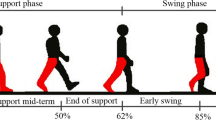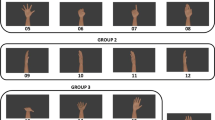Abstract
In recent years, sEMG (surface electromyography) signals have been increasingly used to operate wearable devices. The development of mechanical lower limbs or exoskeletons controlled by the nervous system requires greater accuracy in recognizing lower limb activity. There is less research on devices to assist the human body in uphill movements. However, developing controllers that can accurately predict and control human upward movements in real-time requires the employment of appropriate signal pre-processing methods and prediction algorithms. For this purpose, this paper investigates the effects of various sEMG pre-processing methods and algorithms on the prediction results. This investigation involved ten subjects (five males and five females) with normal knee joints. The relevant data of the subjects were collected on a constructed ramp. To obtain feature values that reflect the gait characteristics, an improved PCA algorithm based on the kernel method is proposed for dimensionality reduction to remove redundant information. Then, a new model (CNN + LSTM) was proposed to predict the knee joint angle. Multiple approaches were utilized to validate the superiority of the improved PCA method and CNN-LSTM model. The feasibility of the method was verified by analyzing the gait prediction results of different subjects. Overall, the prediction time of the method was 25 ms, and the prediction error was 1.34 ± 0.25 deg. By comparing with traditional machine learning methods such as BP (backpropagation) neural network, RF (random forest), and SVR (support vector machine), the improved PCA algorithm processed data performed the best in terms of convergence time and prediction accuracy in CNN-LSTM model. The experimental results demonstrate that the proposed method (improved PCA + CNN-LSTM) effectively recognizes lower limb activity from sEMG signals. For the same data input, the EMG signal processed using the improved PCA method performed better in terms of prediction results. This is the first step toward myoelectric control of aided exoskeleton robots using discrete decoding. The study results will lead to the future development of neuro-controlled mechanical exoskeletons that will allow troops or disabled individuals to engage in a greater variety of activities.
















Similar content being viewed by others
Data Availability
The datasets used or analysed during the current study are available from the corresponding author on reasonable request.
Code Availability
The code used during the current study are available from the corresponding author on reasonable request.
References
Wang, Z. B., Wang, Z. B., Yang, Y. H., Wang, C. Z., Yang, G., & Li, Y. F. (2022). Mechanical design and research of wearable exoskeleton assisted robot for upper limb rehabilitation. Chinese Journal of Medical Instrumentation, 46, 42–46. https://doi.org/10.3969/j.issn.1671-7104.2022.01.009 in Chinese.
Amilibia, M. Z., Cortes, C., Simonetti, A. B., Satrustegi, A., Iturburu, M., Reina, I., Finez, J., Alonso-Arce, M., & Callejo, P. (2021). Preliminary evaluation of an objective assessment approach from session data in exoskeleton-assisted gait rehabilitation after SCI. In 43rd Annual International Conference of the IEEE Engineering in Medicine and Biology Society Mexico, San Luis Potosi. https://doi.org/10.1109/EMBC46164.2021.9630352
Inoue, J., Kimura, R., Shimada, Y., Saito, K., Kudo, D., Hatakeyama, K., Watanabe, M., Maeda, K., Iwami, T., Matsunaga, T., & Miyakoshi, N. (2022). Development of a Gait rehabilitation robot using an exoskeleton and functional electrical stimulation: validation in a pseudo-paraplegic model. Progress in Rehabilitation Medicine, 7, 20220001. https://doi.org/10.2490/prm.20220001
Liu, C., Liang, H. B., Ueda, N., Li, P., Fujimoto, Y., & Zhu, C. (2020). Functional evaluation of a force sensor-controlled upper-limb power-assisted exoskeleton with high back drivability. Sensors, 20, 6379. https://doi.org/10.3390/s20216379
Harith, H. H., Mohd, M. F., & Sowat, S. N. (2021). A preliminary investigation on upper limb exoskeleton assistance for simulated agricultural tasks. Applied Ergonomics, 95, 103455. https://doi.org/10.1016/j.apergo.2021.103455
Pinho, J. P., & Forner-Cordero, A. (2022). Shoulder muscle activity and perceived comfort of industry workers using a commercial upper limb exoskeleton for simulated tasks. Applied Ergonomics, 101, 103718. https://doi.org/10.1016/j.apergo.2022.103718
Huang, R., Wu, Q., Qiu, J., Cheng, H., Chen, Q., & Peng, Z. N. (2020). Adaptive gait planning with dynamic movement primitives for walking assistance lower exoskeleton in uphill slopes. Sensors and Materials, 32, 1279–1291. https://doi.org/10.18494/SAM.2020.2550
Seo, K., Lee, J., & Park, Y. J. (2017). Autonomous hip exoskeleton saves metabolic cost of walking uphill. In: IEEE 2017 International Conference on Rehabilitation Robotics. London, United Kingdom. https://doi.org/10.1109/ICORR.2017.8009254
Liu, H., Tao, J., Lyu, P., & Tian, F. (2019). Human-robot cooperative control based on sEMG for the upper limb exoskeleton robot. Robotics and Autonomous Systems, 125, 103350. https://doi.org/10.1016/j.robot.2019.103350
Vijayvargiya, A., Khimraj Kumar, R., & Dey, N. (2021). Voting-based 1d cnn model for human lower limb activity recognition using semg signal. Physical and Engineering Sciences in Medicine, 44, 1297–1309. https://doi.org/10.1007/s13246-021-01071-6
Gao, B. F., Wei, C., Ma, H. D., Yang, S., Ma, X., & Zhang, S. Y. (2018). Real-time evaluation of the signal processing of semg used in limb exoskeleton rehabilitation system. Applied Bionics and Biomechanics, 2018, 1–6. https://doi.org/10.1155/2018/1391032
Cheng, J., Chen, X., & Shen, M. F. (2013). A framework for daily activity monitoring and fall detection based on surface electromyography and accelerometer signals. IEEE Journal of Biomedical and Health Informatics, 17, 38–45. https://doi.org/10.1109/TITB.2012.2226905
Farina, D., & Negro, F. (2012). Accessing the neural drive to muscle and translation to neurorehabilitation technologies. IEEE Reviews in Biomedical Engineering, 5, 3–14. https://doi.org/10.1109/RBME.2012.2183586
Nurhazimah, N., Mohd, A. A. R., Shin-Ichiroh, Y., Siti, A., Hairi, Z., & Saiful, A. M. (2016). A Review of classification techniques of EMG signals during isotonic and isometric contractions. Sensors, 16, 1304. https://doi.org/10.3390/s16081304
Johan, N., Axel, S., Edmar, C., Daryl, C., Edward, R., Alvaro, F., Johrdan, H., Briggitte, S., & Leonardo, M. C. (2020). Preliminary design of an Intention-based sEMG-controlled 3 DOF upper limb exoskeleton for assisted therapy in activities of daily life in patients with hemiparesis. In: 2020 8th IEEE RAS/EMBS International Conference for Biomedical Robotics and Biomechatronics. New York, USA. https://doi.org/10.1109/BioRob49111.2020.9224397
Wang, C., Guo, Z. M., Duan, S. C., He, B. L., Yuan, Y., & Wu, X. Y. (2021). A real-time stability control method through sEMG interface for lower extremity rehabilitation exoskeletons. Frontiers in Neuroscience, 15, 645374. https://doi.org/10.3389/fnins.2021.645374
Vijayvargiya, A., Singh, P. L., Verma, S. M., Kumar, R., & Bansal, S. (2019). Performance comparison analysis of different classifier for early detection of knee osteoarthritis. Sensors for Health Monitoring, 5, 243–257. https://doi.org/10.1016/B978-0-12-819361-7.00012-9
Fang, H. G., Wang, J., & Kankaanpaa, M. (2005). Comparison of lumbar muscle sEMG between health and LBP patients during dynamic back extensions. In: 2005 IEEE Engineering in Medicine and Biology 27th Annual Conference. Shanghai, China. https://doi.org/10.1109/IEMBS.2005.1616232
Chen, Y. M., Yang, Z. L., & Wen, Y. L. (2021). A Soft exoskeleton glove for hand bilateral training via surface EMG. Sensors, 21, 578. https://doi.org/10.3390/s21020578
Cisnal, A., Pérez-Turiel, J., Fraile, J. C., Sierra, D., & Fuente, E. D. L. (2021). RobHand: a hand exoskeleton with real-time EMG-driven embedded control. Quantifying hand gesture recognition delays for bilateral rehabilitation. IEEE Access, 9, 137809–137823. https://doi.org/10.1109/ACCESS.2021.3118281
Zhuang, Y., Leng, Y., Zhou, J., Song, R., Li, L., & Su, S. W. (2020). Voluntary control of an ankle joint exoskeleton by able-bodied individuals and stroke survivors using emg-based admittance control scheme. IEEE Transactions on Biomedical Engineering, 68, 695–705. https://doi.org/10.1109/TBME.2020.3012296
Lyu, M. X., Chen, W. H., Ding, X. L., Wang, J. H., Pei, Z. C., & Zhang, B. C. (2019). Development of an EMG-controlled knee exoskeleton to assist home rehabilitation in a game context. Frontiers in Neurorobotics. https://doi.org/10.3389/fnbot.2019.00067
Hajian, G., Morin, E., & Etemad, A. (2019). PCA-based channel selection in high-density EMG for improving force estimation. In: 2019 41st Annual International Conference of the IEEE Engineering in Medicine and Biology Society. Berlin, Germany. https://doi.org/10.1109/EMBC.2019.8857118
Wang, G., Zhang, Y. Y., & Wang, J. (2014). The analysis of surface EMG signals with the wavelet-based correlation dimension method. Computational and Mathematical Methods in Medicine, 2014, 284308. https://doi.org/10.1155/2014/284308
Sapsanis, C., Georgoulas, G., Tzes, A., & Lymberopoulos, D. (2013). Improving EMG based classification of basic hand movements using EMD. In: 2013 35th Annual International Conference of the IEEE Engineering in Medicine and Biology Society. Osaka, Japan. https://doi.org/10.1109/EMBC.2013.6610858
Dhar, P., Garg, V. K., & Rahman, M. A. (2022). Enhanced feature extraction-based CNN approach for epileptic seizure detection from EEG signals. Journal of Healthcare Engineering, 2022, 3491828. https://doi.org/10.1155/2022/3491828
Wu, J. H., Zhao, T., Zhang, Y. K., Xie, L., Yan, Y., & Yin, E. W. (2021). Parallel-inception CNN approach for facial sEMG based silent speech recognition. In: 2021 43rd Annual International Conference of the IEEE Engineering in Medicine & Biology Society. Mexico, San Luis Potosi. https://doi.org/10.1109/EMBC46164.2021.9630373
Da, U. J., & Lim, K. M. (2021). Combined deep CNN-LSTM network-based multitasking learning architecture for noninvasive continuous blood pressure estimation using difference in ECG-PPG features. Scientific Reports, 11, 13539. https://doi.org/10.1038/s41598-021-92997-0
Zhang, B., Zhang, H. W., Zhao, G. M., & Lian, J. (2020). Constructing a PM25 concentration prediction model by combining auto-encoder with Bi-LSTM neural networks. Environmental Modelling & Software, 124, 104600.
Konrad, P. (2005). The ABC of EMG: A practical introduction to kinesiological electromyography. USA, Noraxon: Scottsdale, AZ. http://www.demotu.org/aulas/ABCofEMG.pdf. Accessed 29 July 2009.
Leardini, A., Sawacha, Z., Paolini, G., Ingrosso, S., Nativo, R., & Benedetti, M. G. (2007). A new anatomically based protocol for gait analysis in children. Gait & Posture, 26, 560–571. https://doi.org/10.1016/j.gaitpost.2006.12.018
Chowdhury, R. H., Reaz, M. B. L., Ali, M., Bakar, A., Chellappan, K., & Chang, T. (2013). Surface electromyography signal processing and classification techniques. Sensors, 13, 12431–12466. https://doi.org/10.3390/s130912431
Dong, S. X., Zhou, Y., Chen, T. Y., Li, S., Gao, Q. T., & Ran, B. (2021). An integrated empirical mode decomposition and Butterworth filter based vehicle trajectory reconstruction method. Physica A: Statistical Mechanics and its Applications, 583, 126295. https://doi.org/10.1016/j.physa.2021.126295
Huang, S. G., Chung, M. K., & Qiu, A. (2021). Fast mesh data augmentation via Chebyshev polynomial of spectral filtering. Neural Networks, 143, 198–208. https://doi.org/10.1016/j.neunet.2021.05.025
Ni, A., & Qin, L. X. (2021). Performance evaluation of transcriptomics data normalization for survival risk prediction. Briefings in Bioinformatics, 22, 257. https://doi.org/10.1093/bib/bbab257
Tang, Z. C., Zhang, K. J., Sun, S. Q., Gao, Z. G., Zhang, L. K., & Yang, Z. L. (2014). An upper-limb power-assist exoskeleton using proportional myoelectric control. Sensors, 14, 6677–6694. https://doi.org/10.3390/s140406677
Acknowledgements
Thanks to the experiment participants and Nanjing University of Science and Technology for their support of this study.
Funding
The authors did not receive support from any organization for the submitted work.
Author information
Authors and Affiliations
Contributions
Conceptualization: MZ and XRG; methodology: MZ, XRG, and ZL; software: MZ and XRG; validation: ZL; formal analysis: MZ; investigation: MZ; resources: ZW; data curation: MZ; writing—original draft: MZ; visualization: MZ; supervision: KSC.
Corresponding author
Ethics declarations
Conflict of Interest
The authors declare that they have no known competing financial interests or personal relationships that could have appeared to influence the work reported in this paper.
Ethical Approval
The experiment was approved by the review board of The First Affiliated Hospital of Nanjing Medical University and was conducted in accordance with the Declaration of Helsinki.
Consent to Participate
This study was approved by the ethical committee of The First Affiliated Hospital of Nanjing Medical University, and all participants provided informed verbal consent. We obtained the verbal consent of the patient or his immediate family members by telephone and the ethics committee approved this procedure.
Consent for Publication
Written informed consent for publication was obtained from all participants.
Additional information
Publisher's Note
Springer Nature remains neutral with regard to jurisdictional claims in published maps and institutional affiliations.
Rights and permissions
Springer Nature or its licensor holds exclusive rights to this article under a publishing agreement with the author(s) or other rightsholder(s); author self-archiving of the accepted manuscript version of this article is solely governed by the terms of such publishing agreement and applicable law.
About this article
Cite this article
Zhu, M., Guan, X., Li, Z. et al. sEMG-Based Lower Limb Motion Prediction Using CNN-LSTM with Improved PCA Optimization Algorithm. J Bionic Eng 20, 612–627 (2023). https://doi.org/10.1007/s42235-022-00280-3
Received:
Revised:
Accepted:
Published:
Issue Date:
DOI: https://doi.org/10.1007/s42235-022-00280-3




